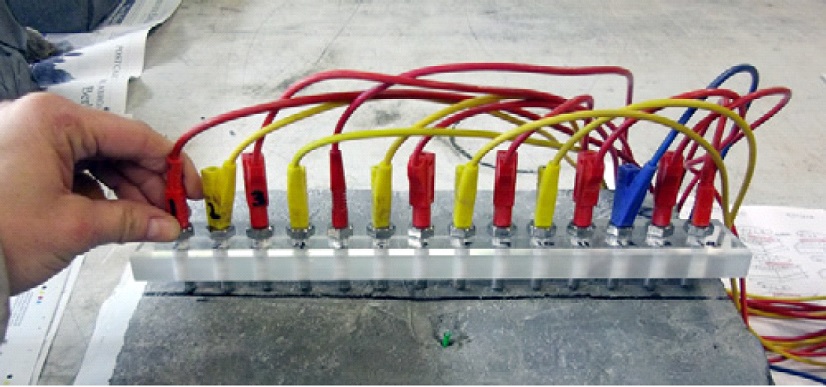Electrical and Electromagnetic Techniques
Electrical tomography
A multi-electrode resistivity probe has been developed to assess the condition and homogeneity of the skin concrete in civil engineering structures. This adaptation to geophysical tomography allows imaging of the material's property gradients within the first 5-7 centimeters in terms of electrical resistivity—a parameter that is highly sensitive to the water and chloride content in concrete.
The resistivity probe consists of a series of 14 point electrodes equipped with conductive sponge tips (4 mm dia.) to minimize contact resistance. They are spaced 20mm apart, sufficient to allow the inspection of concrete mixtures with aggregate sizes up to 13mm, in a Wenner configuration to provide good vertical coverage (approximately 80 mm for this probe).
Finally, a multi-electrode probe for embedding in concrete, for in situ monitoring, and a multi-ring cell for sample characterization in the laboratory, have also been developed.
Contacts

SergioPalma-Lopes
Ingénieur, Chercheur
Co-directeur de l'équipe Géophysique et Évaluation Non Destructive (GeoEND)sergio.palma-lopes@univ-eiffel.fr
+33 (0)2 40 84 59 12Bouguenais
GéraldineVillain
Directrice adjointe du LAMES - Laboratoire Auscultation, Modélisation et Expérimentation sur les infraStructures - Département Matériaux et Structures
Chercheur - Ingénieur - HDR : Évaluation de la durabilité du béton armé par méthodes non destructivesgeraldine.villain@univ-eiffel.fr
+33 (0)2 40 84 57 22Bouguenais
Capacitive technique
The capacitive technique, developed within the network of departments-laboratories of Cerema for over twenty years, provides information on the moisture condition of a flat concrete structure (within the first few centimeters of depth), through the measurement of the resonance frequency of an RLC oscillating circuit, where the capacitor consists of electrodes placed on the structure to be inspected.
The measured resonance frequency—around 33 MHz—varies linearly with the electromagnetic characteristics of the material being inspected. This is why it is highly sensitive to water content and can provide information based on depth (ongoing research through the various projects listed below).
This equipment has several electrode configurations (variable inspection depths) and is designed to record data on computing equipment via radio link.
Contacts

GautierGUGOLE
Technicien
+33 (0)2 40 84 59 13
instrumentation - expérimentationsBouguenais
XavierDerobert
Co-directeur du laboratoire Géophysique et Evaluation Non Destructive (GéoEND)
Chercheur seniorxavier.derobert@univ-eiffel.fr
+33 (0)2 40 84 59 11Bouguenais
GéraldineVillain
Directrice adjointe du LAMES - Laboratoire Auscultation, Modélisation et Expérimentation sur les infraStructures - Département Matériaux et Structures
Chercheur - Ingénieur - HDR : Évaluation de la durabilité du béton armé par méthodes non destructivesgeraldine.villain@univ-eiffel.fr
+33 (0)2 40 84 57 22Bouguenais
Radar Technique
The radar technique (or ground-penetrating radar, GPR) is part of versatile inspection techniques for civil engineering, which can be contactless and highly efficient. Its main application is related to geometric information, in the form of locating heterogeneities or measuring thickness. Its principle is based on the study of electromagnetic wave (EM) propagation (usually in impulse form) and successive reflections that can appear at each interface of the materials constituting the structure/soil being inspected. The frequency bands range from hundreds of MHz for geophysical applications to several GHz for high-frequency NDT applications for civil engineering structures.
Research primarily focuses on the study of EM wave propagation and the modeling of wave dispersion on hydraulic concretes to obtain information on potential gradients depending on the depth (moisture gradient, carbonation...).
Contact

XavierDerobert
Co-directeur du laboratoire Géophysique et Evaluation Non Destructive (GéoEND)
Chercheur seniorxavier.derobert@univ-eiffel.fr
+33 (0)2 40 84 59 11Bouguenais
Frequency hopping radar
The frequency-hopping radar technique reconstructs impulse signals from the emission/reception of monochromatic signals and processing in the form of a Fourier transform. The main advantage of this technique lies in the ability to construct very high-frequency signals up to over 10 GHz, far beyond commercial systems, thus achieving much better resolutions.
Current research focuses on the characterization of interface defects in pavement layers in collaboration with Cerema.
Contact

XavierDerobert
Co-directeur du laboratoire Géophysique et Evaluation Non Destructive (GéoEND)
Chercheur seniorxavier.derobert@univ-eiffel.fr
+33 (0)2 40 84 59 11BouguenaisThibaudDEVIE
Bouguenais
